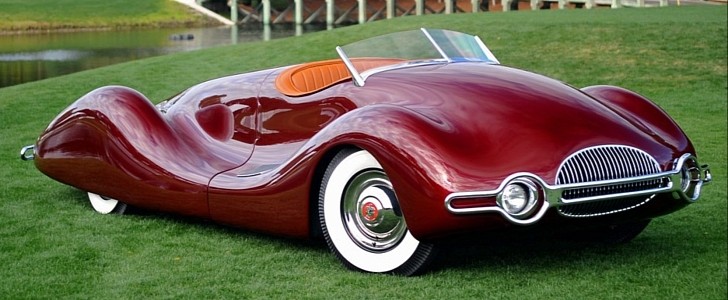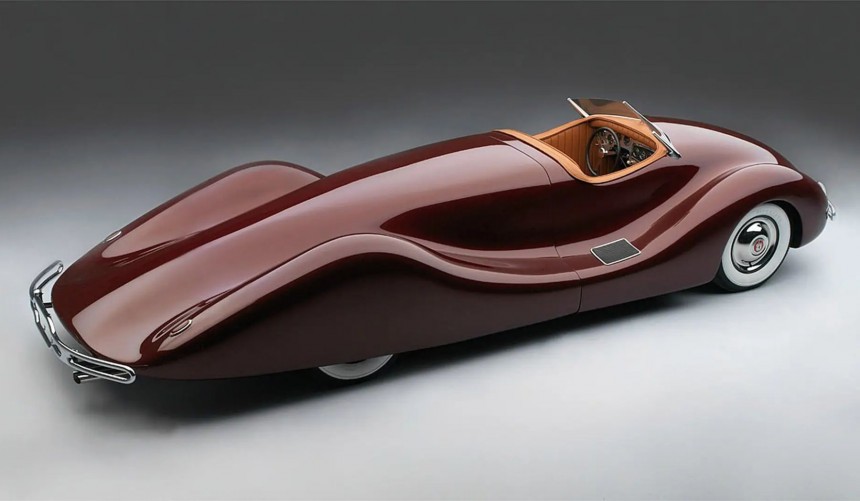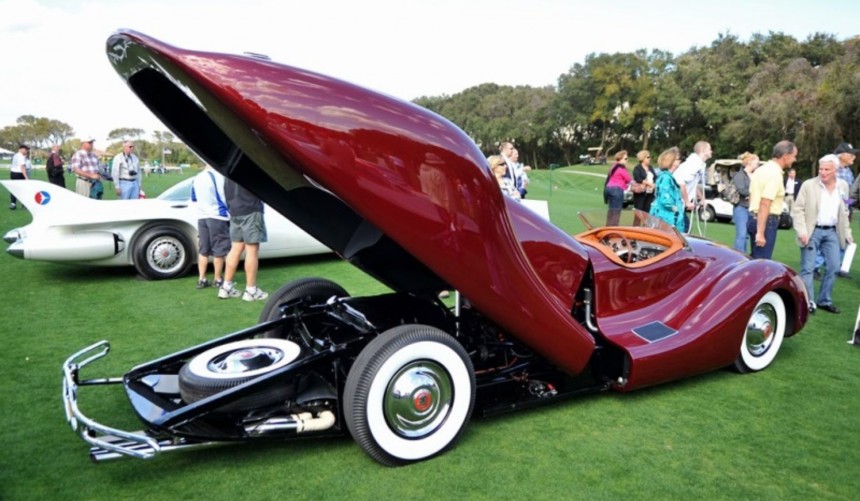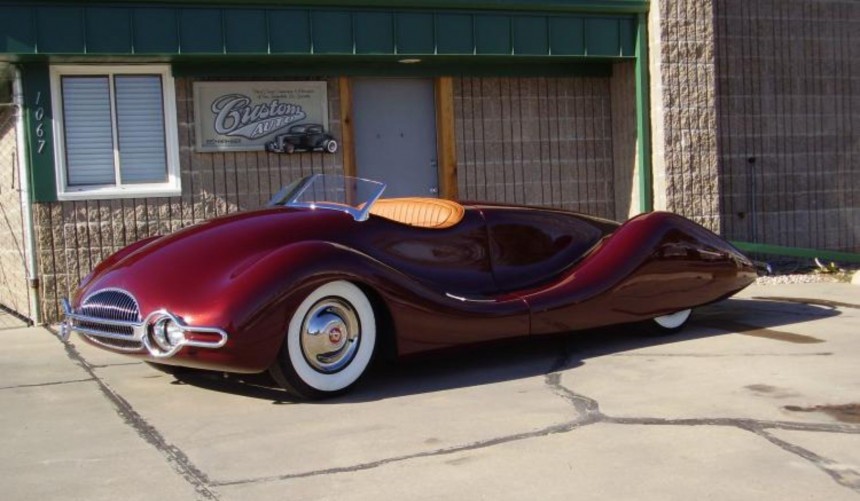About eight decades ago, a talented engineer based in Los Angeles, California, decided to make his wildest dream come true by building a car from the ground up in his spare time. The result was an incredible streamlined, mid-engine, two-seater that has become a timeless custom car icon.
His name was Norman Timbs, and, apart from this ambitious project, he is remembered by senior enthusiasts for pioneering the use of negative pressure underneath race cars (aka. ground effect) or for his contribution to Lou Moore’s Blue Crown Spark Plug Team that won the Indianapolis 500 three years in a row. Timbs also worked for Tucker as a junior engineer as well as the legendary wheel manufacturer Halibrand, designing many of the company’s early products, including the famous quick-change rear axle.
Timbs was a fan of the supercharged V16-powered Auto Union (present-day Audi) streamliners that dominated the Grand Prix scene in Europe before the Second World War, and those fantastic machines would serve as inspiration for his masterpiece.
The story goes that the idea seeped into his mind sometime in the mid-1940s. He put his thoughts on paper, drawing several detailed sketches, which eventually led to several ¼ scale clay models.
After settling on a final design, Timbs began building a chassis for the breathtaking two-seat roadster by welding together a series of aircraft-grade chromoly steel tubing, which is not an easy task today, with the help of modern equipment, but back in the 1940s, getting it right was downright black magic. Nevertheless, the talented engineer succeeded.
Next, he equipped the 117-inch-wheelbase (297 cm) structure with a suspension system comprised of a Ford beam axle in the front, while for the rear, he fabricated a custom independent swing axle around a rigid-mount Packard center section.
For the 17.5-foot-long (5.3 m) body, Timbs crafted a wooden buck, then reached out to one of the best custom builders in the U.S. at the time, Emil Diedt, whom he befriended while working on the Blue Crown Spark Plug cars. The pair hammered out around 100 individual sheets of aluminum which were subsequently welded together to create two sections.
The engineer wanted a streamlined, aerodynamical body with little to no gaps. Thus, there was no hood, trunk lid, or door openings. The only gap separated the front from the rear section, the latter of which lifted when a button was pressed to allow access to the engine and spare tire, thanks to an electronically actuated hydraulic strut.
Everything was finished off with an unpretentious grille, chrome bumpers, a step plate on each side, a pair of Packard headlights, small taillights taken from a 1938 Ford, and a basic roadster windshield.
The cockpit was positioned towards the front end, similar to the aforementioned Auto Union racers. Compared to the gargantuan body, it was extremely small, and apart from the driver, a passenger could barely fit inside. Timbs later upholstered it in tan leather and added a multitude of motorsport-sourced gauges.
Power was delivered to the rear wheels through a three-speed, column-shift gearbox that was coupled to a mid-mounted 1947 Buick straight-eight with a custom, dual carb manifold.
Completed in 1948, the astonishing vehicle was finished in a bespoke gold-flaked maroon paint and must have made jaws drop to the floor every time it took to the streets. A year later, in October 1949, it graced the cover of Motor Trend magazine’s second issue and continued to get a lot of attention from various automotive publications in the years that followed.
In 1954 the Timbs Special (also known as the Buick Streamliner Special) was featured in Motor Life, where it appeared repainted white with license plates attached to the bumpers. According to the article, it was now owned by Air Force Officer Jim Davis of Manhattan Beach, California, who stated that he brought the car in 1952 and was the first person to have it registered for road use.
From that point on, the car’s story gets murky. It apparently spends decades parked in front of an LA restaurant where kids used it as a slide. Then, it was stored outside, behind a barn in the California desert, where it was found in a deplorable state back in 2002.
Shortly after, it wound up in the hands of collector Gary Cerveny who paid around $17,000 for this legendary one-off at a Barrett-Jackson auction. Intrigued by its story, Cerveny located Timbs's son, who fortunately kept his dad’s original scrapbook which contained article clippings and photos of the Special. This enabled the collector to start a seven-year, concurs-quality restoration undertaken by Custom Auto of Loveland, Colorado.
The reborn streamliner made its debut at the Amelia Island Concours d'Elegance in 2010, and for the next eight years, it was driven constantly and displayed at various events all across the country. You can take a virtual tour of this incredible car in the video below posted on YouTube by MyClassicCarTV.
Unfortunately, this automotive work of art, along with Gary Cerveny’s home and his collection of 76 rare vehicles, was destroyed by the Woolsey fire in November 2018. With the chassis surviving, the Norman Timbs Special is set to rise from its ashes as its currently undergoing a complete restoration.
Timbs was a fan of the supercharged V16-powered Auto Union (present-day Audi) streamliners that dominated the Grand Prix scene in Europe before the Second World War, and those fantastic machines would serve as inspiration for his masterpiece.
The story goes that the idea seeped into his mind sometime in the mid-1940s. He put his thoughts on paper, drawing several detailed sketches, which eventually led to several ¼ scale clay models.
Next, he equipped the 117-inch-wheelbase (297 cm) structure with a suspension system comprised of a Ford beam axle in the front, while for the rear, he fabricated a custom independent swing axle around a rigid-mount Packard center section.
For the 17.5-foot-long (5.3 m) body, Timbs crafted a wooden buck, then reached out to one of the best custom builders in the U.S. at the time, Emil Diedt, whom he befriended while working on the Blue Crown Spark Plug cars. The pair hammered out around 100 individual sheets of aluminum which were subsequently welded together to create two sections.
The engineer wanted a streamlined, aerodynamical body with little to no gaps. Thus, there was no hood, trunk lid, or door openings. The only gap separated the front from the rear section, the latter of which lifted when a button was pressed to allow access to the engine and spare tire, thanks to an electronically actuated hydraulic strut.
The cockpit was positioned towards the front end, similar to the aforementioned Auto Union racers. Compared to the gargantuan body, it was extremely small, and apart from the driver, a passenger could barely fit inside. Timbs later upholstered it in tan leather and added a multitude of motorsport-sourced gauges.
Power was delivered to the rear wheels through a three-speed, column-shift gearbox that was coupled to a mid-mounted 1947 Buick straight-eight with a custom, dual carb manifold.
Completed in 1948, the astonishing vehicle was finished in a bespoke gold-flaked maroon paint and must have made jaws drop to the floor every time it took to the streets. A year later, in October 1949, it graced the cover of Motor Trend magazine’s second issue and continued to get a lot of attention from various automotive publications in the years that followed.
From that point on, the car’s story gets murky. It apparently spends decades parked in front of an LA restaurant where kids used it as a slide. Then, it was stored outside, behind a barn in the California desert, where it was found in a deplorable state back in 2002.
Shortly after, it wound up in the hands of collector Gary Cerveny who paid around $17,000 for this legendary one-off at a Barrett-Jackson auction. Intrigued by its story, Cerveny located Timbs's son, who fortunately kept his dad’s original scrapbook which contained article clippings and photos of the Special. This enabled the collector to start a seven-year, concurs-quality restoration undertaken by Custom Auto of Loveland, Colorado.
The reborn streamliner made its debut at the Amelia Island Concours d'Elegance in 2010, and for the next eight years, it was driven constantly and displayed at various events all across the country. You can take a virtual tour of this incredible car in the video below posted on YouTube by MyClassicCarTV.
Unfortunately, this automotive work of art, along with Gary Cerveny’s home and his collection of 76 rare vehicles, was destroyed by the Woolsey fire in November 2018. With the chassis surviving, the Norman Timbs Special is set to rise from its ashes as its currently undergoing a complete restoration.





